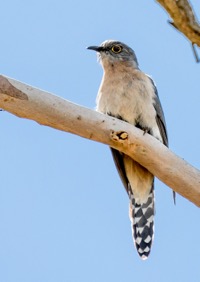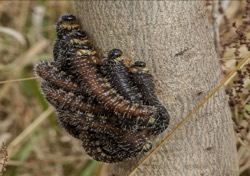New Arrivals
The first trill of a Fan-tailed Cuckoo (Cacomantis flabelliformis) wafted up from the native area this week. These partially migratory birds typically arrive here around September, so this one was either late or was just keeping quiet until now.

One reason for the sudden activity may be that their favourite food – hairy caterpillars – also are rapidly becoming more active. I saw the first bunch of sawfly larva bunched up on the trunk of a young eucalypt on the same day as I heard the cuckoo. Th ese gather in tight groups at the base of trees for mutual protection during the day, and presumably for warmth in cold weather, then disperse across the tree overnight to chomp away at the new leaves.
ese gather in tight groups at the base of trees for mutual protection during the day, and presumably for warmth in cold weather, then disperse across the tree overnight to chomp away at the new leaves.
Here are some interesting cuckoo factoids courtesy of Birdlife
- Only one cuckoo found in Oz actually calls “cuckoo” – the Oriental Cuckoo visitor – which you will not find around here
- Our only ground-cuckoo, the Pheasant Coucal builds its own nest — a shallow platform of grass — and raises its own young, but it also is not in our area
- After laying her egg in another bird’s nest, a female cuckoo typically steals one of the host’s eggs and throws it away to maintain the size of the clutch
- When young cuckoos hatch, they often instinctively tip other nestlings or eggs out of the nest to ensure they monopolise the food provided by their host ‘parents’
- Many of Australia’s cuckoos are migratory, and most call incessantly after they arrive back at their breeding grounds – the loud night-time coo-ee of the Eastern Koel is the most infamous, but these are not found in Victoria.
– Article and images by Greg Holland.